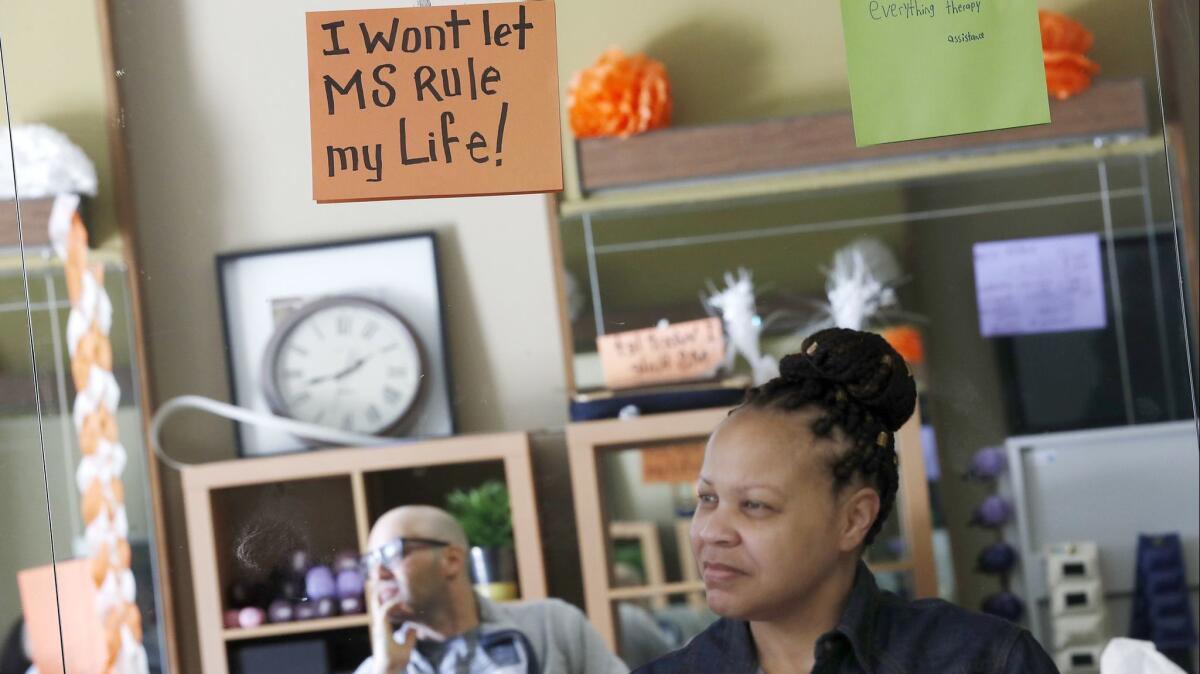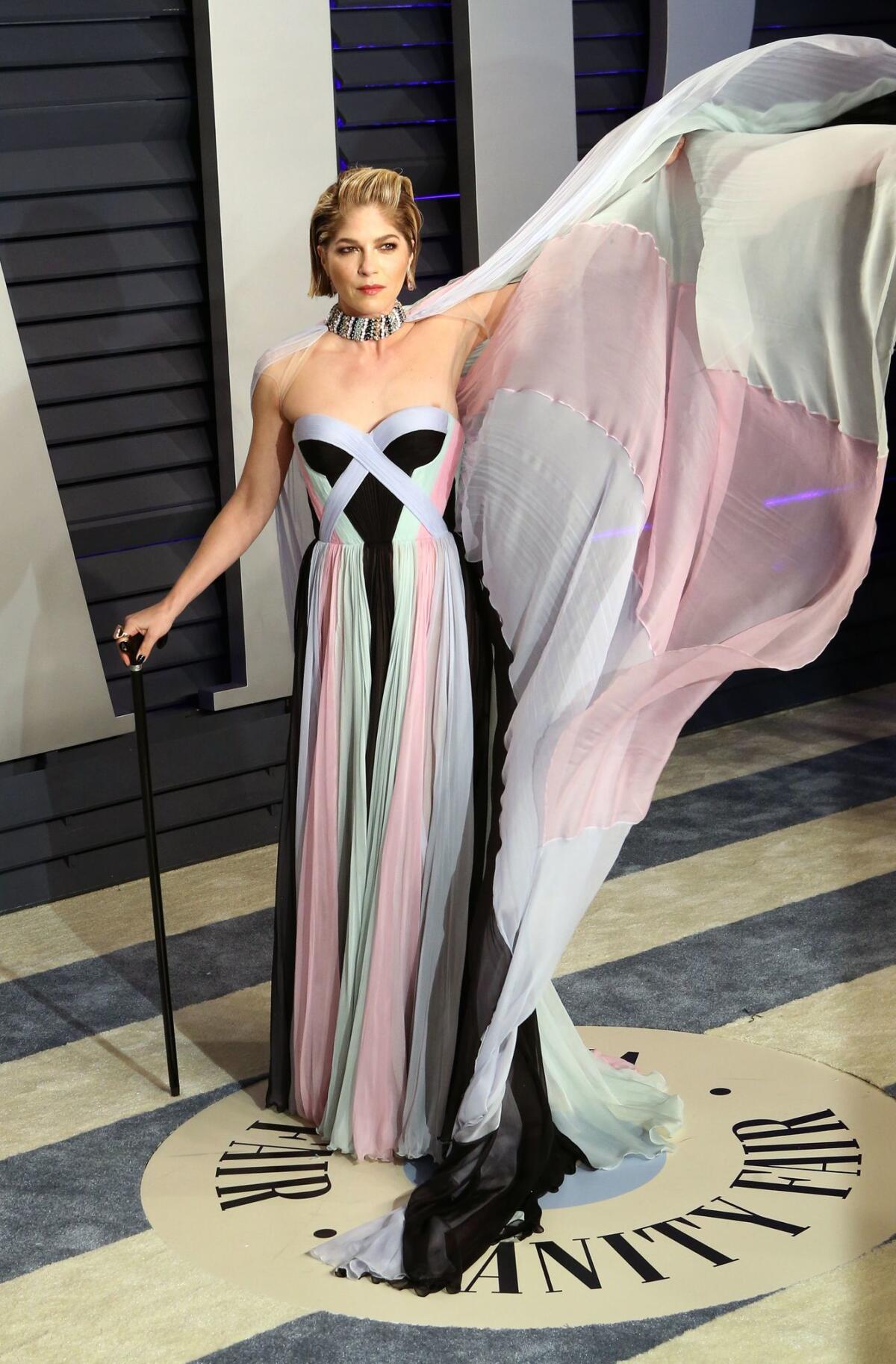How actress Selma Blair — and that cane — inspire others with MS

- Share via
When actress Selma Blair strode onto the Vanity Fair red carpet on Oscar night, her most public appearance since announcing in October that she has multiple sclerosis, what drew most attention was not her couture but her cane. Not utilitarian medical supply, foam and stainless steel, but sheathed in patent leather, and embellished with a pink diamond and gold monogram — a signal, both brash and heartening, to others living with the disease.
“Kudos to her for her stepping out like that, and looking beautiful. I think she encouraged a lot of people,” said Dawnia Baynes, 39, of Compton, who was diagnosed with MS in 2006. “She helped me be like, ‘Who cares? This is what I’m dealing with.’ Now I want to trick out my walker! Bling it out! Put some spinners on it!”
Blair, who first gained a cult following with 1999’s “Cruel Intentions,” walked carefully and deliberately across the carpet, pausing and smiling for each barrage of paparazzi strobes, waving the diaphanous cape of her Ralph & Russo gown, maintaining her balance while showing off that cane. She broke down momentarily halfway along, and with the help of her friend and manager Troy Nankin, composed herself, then turned an unflinching gaze toward every lens trained on her.

“That was awesome,” said Nandi Bowe, 55, a writer and director in Silver Lake, diagnosed 13 years ago. “All of a sudden, it took a little bit of the fear away. I’m not in a club of one, or a club of 10. MS can look lots of ways. MS can look like a fabulous, beautiful actor.”
Blair’s confidence and openness about the disease come at an especially important time, according to Cyndi Zagieboylo, president and chief executive of the National Multiple Sclerosis Society. Not just that March is MS Awareness Month, but because a study published earlier this year revealed that twice as many people in the United States have MS than previously thought.
The disease strikes the central nervous system, causing symptoms ranging from numbness and tingling to blindness and paralysis. But because it’s not infectious, doctors aren’t required to report cases, so prevalence has been hard to pin down. The old estimate, about 400,000 people nationwide, was extrapolated from a 1975 study; the new research, published in the medical journal Neurology, puts the number at almost 1 million.
The new tally shows the urgency for more funding and research, and will help indicate whether the disease is growing, or appears in geographic clusters, Zagieboylo said. At the same time, Blair’s panache can dispel insecurities among those with MS, and raise awareness — not just for donations, but to spur people into getting checked.
After Blair revealed her diagnosis in October, the MS Society said traffic on its web site increased 200% from the same time a year earlier — though there’s no guarantee the two are related. And after her red carpet turn in February, visits to the page “Definition of MS” were more than 300% higher than the same time in 2018.

Blair announced her diagnosis on Instagram, and since then has chronicled her life with the disease, with honesty and self-deprecating humor, via the web and through interviews on “Good Morning, America” and in this month’s Vanity Fair.
The actress said she’d had symptoms for years — fatigue, numbness, loss of coordination and others — but either ignored them, or was misdiagnosed. Finally, after an MRI in August, she got a definitive answer, and cried tears of relief.
“I’ve heard that from people,” that an MS diagnosis is not devastating, Zagieboylo said. “To have a name for it — ‘You have MS, and here’s what you can do for it’ — is much more powerful.
“One of the things so tricky about MS is that it varies from person to person, but also that it varies within each person,” she said. That’s why people often take so long to get diagnosed.
According to the NMSS, the disease is rarely fatal, but its complications increase the risk of heart disease, stroke and other problems. Researchers are still unsure what causes MS, and though there’s no cure, treatments can alleviate some symptoms. It affects women up to three times more often than men, usually between the ages of 20 and 50.
“Women in the prime of their lives,” Bowe said. “What a cruel time to be affected by this debilitating disease.” (Unable to hike with her three sons, Bowe said now a simple trip to the mall requires mental calculations about walking distance, bathrooms, crowds and even temperature.)
Blair, currently starring in the Netflix series “Another Life,” wisecracks about the ordeal of simply getting dressed, even with help. She has long ventured into the fashion realm — as a collaborator with numerous designers, the onetime face of Chanel and a frequent guest at New York Fashion Week. Now she hopes to create her own line of adaptive clothing, joking that she’ll make elastic waistbands chic.
Zagieboylo credits Blair for talking frankly “about her appearance, and how she looks, and how that’s important to her.”
“Some people, that’s what keeps them hidden,” she said, shame over not presenting like they used to. But Zagieboylo said Blair is owning it: “I got a cane, and it’s beautiful, and it should be beautiful.”

Baynes, who runs a support group for people with MS in their 20s through 40s, lauds Blair’s desire to keep working, and said people with the disease sometimes “shut down.”
“Don’t cancel things, or feel like you’re being a burden to someone,” she said. “You do need a community.”
Luis Lemus, 31, of Norwalk, was diagnosed in 2014, and — like Blair — exhibits the rare symptom spasmodic dysphonia, which affects the larynx and causes strained, halting speech. But he’s also a communications major at Cerritos College, planning to graduate in the spring then move on to Cal State Fullerton.
“If someone tells me, ‘Oh, you can’t do that,’ I personally see that as a challenge,” he said. “I lost coordination, but I’m still pursuing school. I don’t let this define me.”
Lemus said he feels the disability has cost him friendships and party invites, but admits his own fears sometimes made him cautious and closed-off.
But Blair inspired him.
“Because of her, and her fancy cane, she put her own fashionable spin on the horrible disease, and I can only hope it works out in her — in our — favor,“ he said. “In my case, I see it as a second chance to do what, in the past, I would have passed on.”
More to Read
The biggest entertainment stories
Get our big stories about Hollywood, film, television, music, arts, culture and more right in your inbox as soon as they publish.
You may occasionally receive promotional content from the Los Angeles Times.










